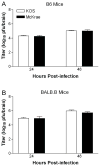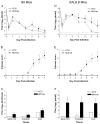HSV-1 strain McKrae is more neuroinvasive than HSV-1 KOS after corneal or vaginal inoculation in mice
- PMID: 23339898
- PMCID: PMC3640688
- DOI: 10.1016/j.virusres.2013.01.001
HSV-1 strain McKrae is more neuroinvasive than HSV-1 KOS after corneal or vaginal inoculation in mice
Abstract
Strains of HSV-1 have been noted to vary in their pathogenesis. We compared the replication of strains KOS and McKrae in mice by two routes of infection, ocular and vaginal. Peripheral replication of KOS was similar (cornea) or attenuated over time (vagina) compared with McKrae; however, McKrae replicated in the nervous system to significantly higher levels than KOS after inoculation by either route. Host genetic background strongly influenced the capacity for virus entry into the nervous system from the vagina. KOS and McKrae replicated equivalently after intracranial inoculation, indicating that McKrae's pathogenic phenotype is linked to neuroinvasiveness rather than neurovirulence.
Copyright © 2013 Elsevier B.V. All rights reserved.
Figures



References
-
- Archin NM, Atherton SS. Rapid spread of a neurovirulent strain of HSV-1 through the CNS of BALB/c mice following anterior chamber inoculation. J Neurovirol. 2002;8:122–135. - PubMed
-
- Berman EJ, Hill JM. Spontaneous ocular shedding of HSV-1 in latently infected rabbits. Invest Ophthalmol Vis Sci. 1985;26:587–590. - PubMed
Publication types
MeSH terms
Grants and funding
LinkOut - more resources
Full Text Sources
Other Literature Sources

